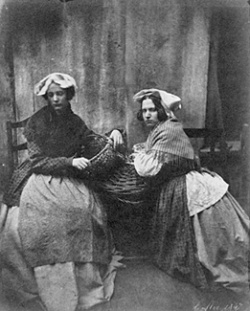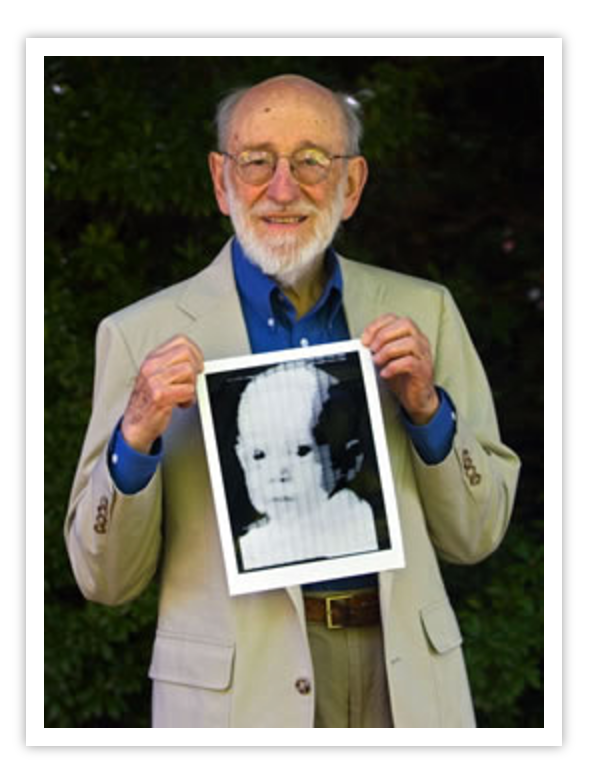Camera Obscura and Pinhole Photography
Camera Obscura is a natural phenomenon in which you have a dark room/chamber and allow light rays to pass through a small hole. These light rays will project an inverted image of the view from outside onto a surface within the dark room. This is similar to how a modern camera works as the camera is the dark chamber and the hole for light is the aperture. The mirror in modern cameras flips the image around so it is no longer upside down. Furthermore, in the 16th century, camera obscura became a popular drawing and painting aid as people would use the projected image to trace it.


Here is an example of the use of camera obscura. This took place in Venice in 2006 and depicts a projection of Santa Maria della Salute on a bedroom wall.
Camera Obscura is still used to this day, an example being the work of Susan Derges. Susan Derges works with nature to produce her images by going out at night and submerging light sensitive paper under water, allowing the moonlight to transfer the image on to the paper.

Nicephore Niepce – Heliography
Joseph Nicephore Niepce was a French Inventor and Photographer, born in 1765. Niepce lacked in artistic ability so used Camera Obscura as a drawing aid, in which he later used to create the process ‘heliography’. He created this process in 1822 and used it to capture the World’s very first permanent photograph. This photograph was of Pope Pius VII, however, it was later destroyed after Niepce attempted to make prints from it. In 1816, Niepce would send letters to his sister-in-law containing small images on paper coated with silver chloride, however, they were negatives and when they were exposed to light for viewing they would go dark all over. Niepce then explored other substances that were affected by light and became intrigued by how bitumen coating would become less soluble after being left exposed to light. This went on to his creation of the heliograph where he would dissolve bitumen in lavender oil and use it to coat either a lithographic stone, a sheet of metal or a sheet of glass and leave it to dry. He would then cover it with an engraving printed on paper and leave it in direct sunlight so that, after sufficient exposure, he could use the lavender oil to rinse away the unhardened bitumen which had been sheltered from sunlight by the lines/dark areas in the engraving. Finally, he would etch the remaining details in with acid. Later, after Niepce’s passing in 1833, his invention was overshadowed by the invention of his partner’s Daguerreotype, an improvement of the Heliograph.

Louis Daguerre – Daguerreotypes
Louis Daguerre was a French artist and photographer, recognised for inventing a way to fix the projected image of Camera Obscura, known at the Daguerreotype. The invention of the Daguerrotype was announced on the 19th of August, 1839 at a meeting of the French Academy of Science in Paris. A Daguerrotype is sometimes referred to as a ‘mirror with memory’ and it was originally made by, first, polishing a sheet of silver-plated copper to look like a mirror then making it sensitive to light by using Iodine in a closed box. After this, camera obscura was used to expose the surface to light and create an image. This would take a range of 3 to 15 minutes. Finally, this image was fixed by desensitising the sheet to light using sodium thiosulfate or salt with gold chloride.

The surface of daguerrotypes are very delicate and they can be ruined just by wiping them, therefore, they were often blowtorched around the edges to be sealed and put into protective cases/picture frames.


Henry Fox Talbot – Calotype
Henry Fox Talbot was an English scientist, inventor and photographer who invented a photographic process known as the Calotype, otherwise known as the Talbotype. This was an improvement over the Daguerreotype as multiple prints could be made from it and the exposure time was only a couple of minutes, however, the Daguerreotype could only be reproduced by copying it with a camera and took longer for the photo to be produced. Prior to the Calotype, Henry created a process known as the “photogenic drawing” process which produced paper negatives on light-sensitive paper with silver salts. This was similar to Nicephore Niepce’s Heliograph, however Talbot found a way to prevent the photographs from darkening when being again exposed to sunlight. The Calotype was a modified version of this process with a faster exposure time and development process and it allowed negative prints to be made positive through contact printing.
Below is the earliest surviving negative by Talbot, depicting the lattice window at Lacock Abbey, made in August 1835.


William Collie was a photographer who was born in Scotland in 1810 but moved to Jersey in 1841. He was one of the earliest photographers in the Channel Islands and had a portrait business at Belmont House in St Helier. Collie was the first known photographer to use this photographic process in Jersey and in the late 1840s made a series of Calotypes depicting ‘French and Jersey Market Women’.

Robert Cornelius – Self Portraiture
Robert Cornelius, born in Philadelphia in 1809, was an inventor, businessman and lamp manufacturer. He worked for his father in his lamp shop and specialised in silver plating and metal polishing. After being hired by a Client to produce a silver plate for a daguerreotype, Cornelius became intrigued by the process.
At just 30 years old, Robert Cornelius was believed to have taken the world’s very first portrait in 1839. He took this image just two months after the announcement of Daguerre’s Daguerreotype outside the back of his family’s store in Philadelphia. He created this portrait by removing the lens frame and running to stand in front of the camera completely still for 10-15 minutes then covering the lens back up. Cornelius wrote on the back of this Daguerreotype “The first light Picture ever taken. 1939.”

Henry Mullins – Carte-de-Visite
The Carte de Visite, translating to ‘visiting card’, was a small photographic portrait, typically 54 x 89mm in size mounted onto a piece of card 64 x 100mm in size. They became increasingly popular in the 1860s and were exchanged among friends and family to create albums.

Henry Mullins was a photographer who moved to Jersey in 1848. Between his relocation in 1848 to 1873, Mullins produced thousands of photographs of Islanders, with almost 10,000 available to view online. He owned a successful studio in the Royal Square in St Helier and was the photographer of choice for the Island’s leading members and wealthy families.

Richard Maddox
Richard Leach Maddox, born in England in 1816, was a photographer and physician who, in 1871, invented lightweight gelatin negative dry plates for photography.


These dry plates are an adaption to Frederick Scott Archer’s Collodion process, which was invented in 1851. These plates had to be sensitised at the time of exposure, meaning that the emulsion was still wet and produced ether vapour which can affect a person’s health.
Richard Maddox’s dry plates consisted of a glass plate coated with light-sensitive gelatine emulsion that was left to dry before use. This allowed photographers to use commercial plates off a shelf, rather than have to prepare their emulsions. It also allowed for cameras to be smaller and have faster exposure times. This process was developed and eventually led to the ‘Kodak’ Camera.
George Eastman – Kodak
George Eastman was an American entrepreneur, born in New York in 1854, who founded the Eastman Kodak Company. Kodak being a word he created himself. Due to the passing of Eastman’s father, he had to leave school at the age of 14 to support his family financially. In the 1870s, whilst George was working as a Bank Clerk, he became interested in photography and, in 1879, created a machine for coating dry plates. In 1881, alongside Henry Strong, George founded the Eastman Dry Plate Company. He then began experimenting with film roll to replace plates and invented the Kodak Film Camera, in which he released in 1888.

This camera could be hand-held and was designed so that it was simple for anyone to use, with just the click of a button. Additionally, the camera was pre-loaded with enough film for 100 photos, priced at $25, and once the film had been used up it could be returned to develop the film and have new film inserted for $10. Eastman’s slogan was “You press the button, we do the rest”.
In 1990, Eastman Kodak released the Brownie Box Camera, a camera designed for use by anyone, including children. The initial price of the Brownie was just $1, equivalent to $37 in 2023, due to it being a basic cardboard box camera with simple controls. This became an increasingly popular camera for photography and many other models of it were later created by Eastman Kodak.


Digital Photography
Digital Photography first came in to being in the 1950s when the first video tape recorders were developed in 1952. Later, in 1957, Russel A. Kirsch created the first ever digital image. It was a portrait of his son which he produced using a Drum Scanner, technology that could sense the differences between light and dark in an image.

In 1969, Willard Boyle and George Smith invented CCD (charged-coupled device) chips. These could be used in video cameras and by 1975 CCD cameras were being used for broadcast television. In December 1975, Steven Sasson, an electrical engineer and inventor at Eastman Kodak, produced the very first true digital camera using CCD chips. This was a large, battery-operated, self-contained camera, weighing 8 pounds, with a resolution of 0.1 megapixels and image production time of 23 seconds. The images from this camera were digitally recorded onto a cassette tape.

From then on, digital camera technology has continued to evolve to this day and they are now everywhere, from DSLRs to phones, computers, cars and more.
